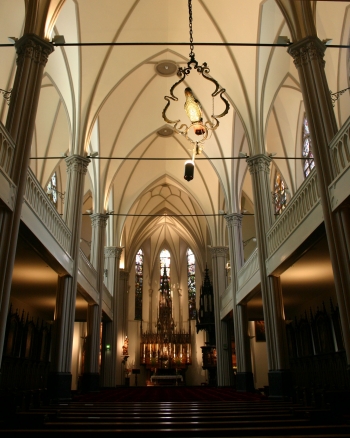From its website:
St. John Cantius is a unique church in the Archdiocese of Chicago — helping many discover a profound sense of the Sacred through solemn liturgies and devotions, treasures of sacred art, and liturgical music.
The historic landmark church is one of the best examples of sacred architecture in the city. Located in the heart of Chicago, it is accessible by car, bus, or subway.
The parishioners of St. John Cantius love the Latin Liturgy. They see in the Sacred Rites of the Church an intrinsic beauty that has a transformative power over the soul. The Bride of Christ, the Catholic Church, understands the sacramental nature of her own liturgy, and so our Holy Mother the Church understands that beauty in liturgical gestures and monuments can reflect the beauty of God and direct the faithful towards God. This is why Catholic liturgy is enriched by an atmosphere rich with “smells and bells.” This is why the founding parishioners of St. John Cantius made great sacrifices to build a majestic parish church, replete with sacred art, meant to last for generations to come.
The Roman Liturgy enjoys, in particular, a long and glorious tradition of sacred music, which Vatican II calls “a treasure of inestimable value, greater even than any other art.” Catholics, therefore, are called, not just to sing at Mass, but to sing the Mass. At St. John Cantius a deep appreciation of sacred music is fostered. Sacred chant and polyphony, along with sacred organ music are a regular part of the liturgies of St. John Cantius Parish.
But just as the planets rotate about the sun, the hours of the Divine Office revolve around the Holy Sacrifice of the Mass, sanctifying every hour of the day and night. And so the faithful are called to join the members of the Canons Regular of St. John Cantius in singing daily the official prayer of the Church, the Divine Office. The Divine Office unceasingly chants the Davidic Psalter and joins the ceaseless singing of the choirs of angels.
In addition to the Mass and Office, the traditional customs, novenas, and devotions that accompany the seasons of the liturgical year, enhance the liturgical life of the parishioners of St. John Cantius Church. This devotional life fosters a deep love of the Real Presence of Jesus Christ in the Holy Eucharist, as well as devotion to the saints, who are the friends of God.
On Sundays, the 11:00 AM holy Mass is celebrated in the Ordinary Form (Novus Ordo) in Latin and broadcast live on “St. John Cantius Church” YouTube channel.
825 N. Carpenter St.
Chicago, IL 60642
312-243-7373





